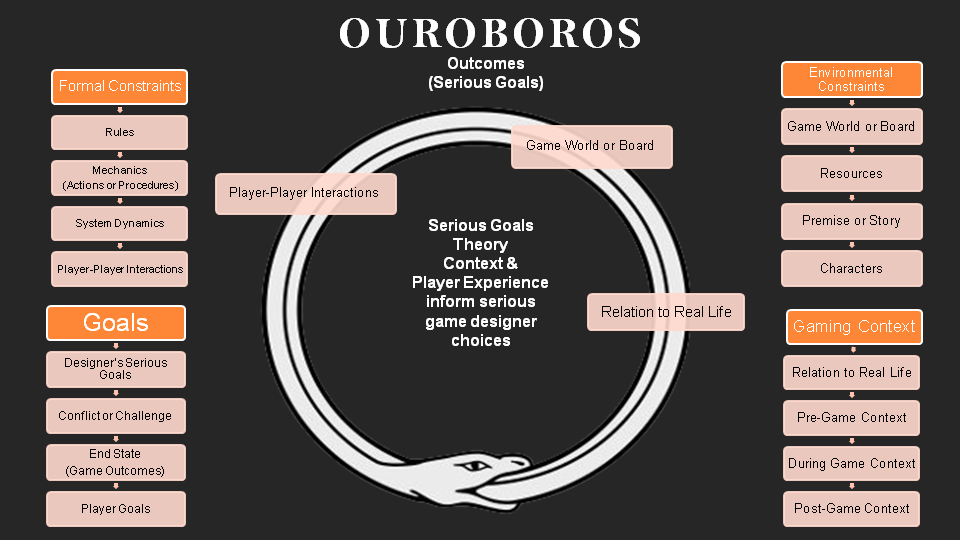Background
I. Problem Statement
No great alternatives to the dull and cumbersome DMV books that student drivers must read in order to learn the rules of the road exist today. This is a troubling situation particularly for teenagers, who are the most at-risk population on our roads today. Car accidents are the leading cause of death for teenagers in the US. Several new distractions, such as mobile devices, and age-related problems, such as peer pressure to drink and do drugs, may lead teens to drive in potentially lethal situations that not only endanger themselves, but the population at large.
II. Target Audience
Testdrive USA’s target player audience consists of 14- to 18- year-olds applying for their first driver's license and their families.
III. Ouroboros Magic Circle
The ouroboros is an ancient symbol of a serpent eating its own tail and, for me, it symbolizes in this context the way in which games have to continually evolve. These four main elements of serious games that you see around the circle are important for game designers to consider when trying to design effective games. I chose three of these elements that seemed to be most relevant to Testdrive USA below.

Fig. 2. The Ouroboros Magic Circle
Clearly, the concept of relating to real life situations is essential. The game board itself aids in this regard as it offers an attractive and intuitive representation of a city. The player can easily identify different areas, such as residential, commercial, and recreational areas. The condition cards are relevant to the area of the board where they are located, and provide information regarding particular conditions that the player may encounter in real-life situations. Finally, the player to player interactions are key to the gameplay. Players learn from each other as they read the condition cards aloud and understand collectively which types of behaviors are awarded and which are not. Each of these three elements work together to enhance the player's learning experience in meaningful ways.
IV. Content Sources
The background sources used for this project include government publications on highway safety, such as "Traffic Safety Facts 2008: Young Drivers" and "The Traffic Stop and You: Improving Communications between Citizens and Law Enforcement", both published by the National Highway Traffic Safety Administration. The 2012 California Driver Handbook was also referencedl to determine how appealing (NOT!) it is to teenagers to learn to drive using that resource. Other sources include websites that provide statistical information and analysis on teenagers' driving habits that result in public hazards, such as using cell phones while driving. The following is a list of websites from which I pulled some background statistics:
- http://www.textinganddrivingsafety.com/texting-and-driving-stats
- http://www.textingthumbbands.com
- http://www.rmiia.org/auto/teens/Teen_Driving_Statistics.asp
- http://www.dosomething.org/tipsandtools/11-facts-about-teen-driving
V. Values
Safe driving skills are valued and embeded throughout the game, mostly through use of the condition cards. Players learn about the consequences of different actions under certain circumstances, such as texting while driving, speeding or tailgating, for example. Not all the consequences are negative. The game acknowledges good and safe practices while driving, such as refusing to drive after drinking, and rewards the player as a result.
VI. Fun/Engagement
The game is fun because the player collects errand cards and feels a sense of achievement. Testdrive USA gives the players the opportunity to talk about safety in different driving situations in an environment that is not awkward or forced.
Learning that incorporates fun is important to teenagers, and this is exactly what Testdrive USA aims to do. The goal is that players will be grateful to learn practical solutions to real-life situations they may face on the road on a daily basis.
VII. Theory
A few theories were put to the test in the design of Testdrive USA. Specifically, John Ferrara´s theory on the planes of motivation, meaningful choices, balance, usability, and aestheticsm, which he outlines in Playful Design, were major influences in the first prototype design. In fact, one place where the game needs to improve in future iterations is in the area of meaningful choices. This was one of the most challenging aspects of the project, and the first playtesting session revealed that addressing that issue will be key to improving the gameplay and achieving the game´s serious goals.